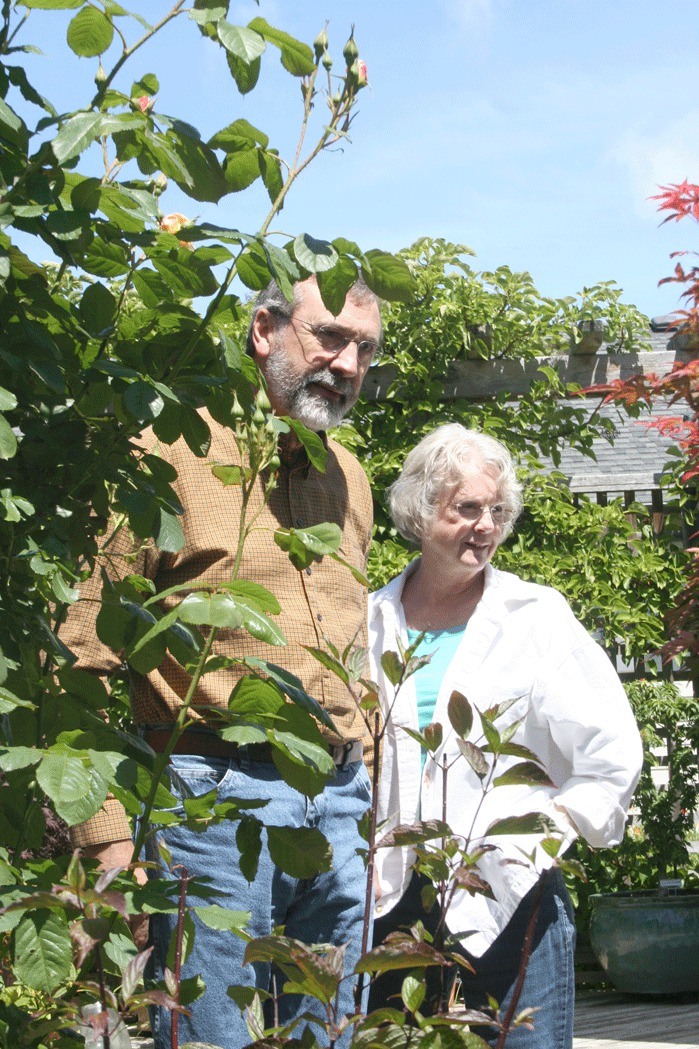In the Chamberlins’ garden, Japanese maple trees with red or white leaves grow among rhododendrons and magnolia trees. A fountain burbles quietly in the outdoor living space at the back of the house, a shaded refuge of roses and begonias. On the other side of the house, a gravel path meanders through greenery to raised vegetable beds.
The best part about Katie and Kermit Chamberlins’ garden is that it will be open to the public during the 17th annual Whidbey Island Garden Tour Saturday, June 23. Four South Whidbey gardens will open to the public for visitors to enjoy the gardens and learn a trick or two.
The Whidbey Island Garden Tour is not a garden club; it is a nonprofit that raises funds for local groups and programs that protect and enhance island habitat. Since 1996, the tour has raised over $285,000 and given out over 50 grants. The Good Cheer Food Bank was established with a $5,000 grant from the tour.
The Chamberlins began gardening at their Freeland home 15 years ago. This is their first year participating in the garden tour.
“We like a garden you can just wander in,” Katie Chamberlin said. With various seating areas and shaded hideaways, the garden wrapping around their home seems to transform the spot into a fantasy getaway. But what makes the Chamberlins’ garden so special is that it shows visitors what they can do on their own.
“It’s really to show people you can do something with a relatively small space and you don’t need a crew to do it; you can do it yourself,” Katie Chamberlin said. Their lot is one-half acre total. They’ve done all the work themselves over the years, adding plants slowly and moving them around as needed, leading them to refer to it as “random acts of planting.”
“You can do a lot of vegetable gardening in a small space if you put your mind to it,” Kermit Chamberlin said. From their raised beds, which Kermit Chamberlin built, they gather enough vegetables for themselves, neighbors and extra for the Good Cheer Food Bank.
The rhododendrons and Japanese maples are the foundation of the garden.
“I don’t think you can have too many Japanese maples. They’re a great tree,” Katie Chamberlin said, noting the variety of textures, sizes and leaves. “And rhodies, well, they do well in the state.”
Another important aspect of having a Whidbey garden is keeping the deer out. Kermit Chamberlin built the fencing to protect their garden. He also built an outbuilding for storage and wintering plants that matches the architecture of the house.
The Chamberlins’ garden can also teach visitors about drip irrigation.
“A lot of people water and they spray water into the air and it evaporates and is wasted,” Kermit Chamberlin said. To conserve water, the Chamberlins put in a series of black tubes on the ground that end in devices that allow water to drip at various rates onto plants.
“You can control your water use because you can give the plant just what it needs,” Katie Chamberlin said. They adjust the drip rate based on the plant’s age and the weather.
“We can really pay attention to what’s happening with the weather and time it so we can turn it on when it’s dry and not likely to rain for another three days,” Kermit Chamberlin said. He said it’s easy to find the materials to build your own system at Ace Hardware or other hardware stores.
Another aspect of their garden that visitors will appreciate is that “easily more than 95 percent of this garden was sourced on Whidbey Island. You don’t have to go all around the world to find it,” Kermit Chamberlin said. He cited Ace Hardware, Cultus Bay Nursery, Bayview Farm and Garden and Meerkerk Gardens as places they most frequently purchase plants. All the building materials for the raised beds, fencing and outbuilding also came from within a few miles of home, he added.
While their garden may appear to be a verdant masterpiece now, the Chamberlins said it’s always changing and there’s always something new to learn.
“Gardening is a process. It’s a journey. It’s not a destination,” Kermit Chamberlin said, adding that going to garden tours over the years has helped them.
“It kind of stimulates your own thought process and what you can do on your own,” Katie Chamberlin said.
As they finish readying their garden for the garden tour, they said they’re looking forward to sharing their efforts.
“I’m really kind of glad to have the opportunity to share with a larger audience,” Kermit Chamberlin said. “I’m glad that what we do gives pleasure to other than us.”
“But that would be fine too,” Katie Chamberlin added.
For information about the garden tour and to buy tickets, visit www.wigt.org.
Whidbey Island Garden Tour
Enjoy nature, be inspired and learn tips to transform your garden.
When: 10 a.m. to 4 p.m. Saturday, June 23.
Where: Four South Whidbey gardens.
Tickets: $20 adults; $10 ages 2 to 12.
For information or to buy tickets: 360-321-4191; www.wigt.org.



